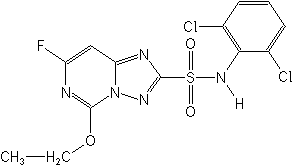-
Common NameDiclosulam
-
中文通用名双氯磺草胺
-
IUPACN-(2,6-dichlorophenyl)-5-ethoxy-7-fluoro-[1,2,4]triazolo[1,5-c]pyrimidine-2-sulfonamide
-
CASN-(2,6-dichlorophenyl)-5-ethoxy-7-fluoro-[1,2,4]triazolo[1,5-c]pyrimidine-2-sulfonamide
-
CAS No.145701-21-9
-
Molecular FormulaC13H10Cl2FN5O3S
-
Molecular Structure
-
Category
-
ActivityHerbicide.
Diclosulam is effective against a range of important broadleaf weeds in soybean crops including morningglories, cocklebur, eclipta, velvetleaf and nutsedge, and also controls important weeds in the major peanut-growing areas of the US. It does not control sicklepod.
Diclosulam offers peanut growers greater flexibility by allowing pre-emergence control of weeds previously controlled only by post-emergence treatments. In most cases, it will not remove the need for post-emergence applications but it is expected to reduce the number by 1-2. Currently, growers may make up to 4 post-em treatments per season.
Strongarm can be applied preplant to the surface or incorporated into the top 1 - 3 inches of soil, not more than four weeks before planting. It can also be applied from premergence through to cracking in peanuts. For best results, Dow recommends that the fields should be clean-tilled and weed-free, the product should be applied as close as possible to planting, and 0.25 - 0.5 inches of water should be applied immediately if irrigation is available. For post-emergence control in peanuts, diclosulam should be applied when weeds are at the 1 - 4 leaf stage. In tillage systems, Dow suggest that Strongarm may be tank mixed with a burndown herbicide such as Gramoxone Max to control existing weeds.
Dow recommends a tank mixture of diclosulam and Syngenta's Dual (metolachlor) for the control of heavy infestations of nutsedge. For broad spectrum weed control a tank mix with a graminicide such as Sonalan HFP (ethalfuralin) is recommended. Diclosulam is also found to be more effective when applied in combination with Frontier, Outlook or Prowl. Application of Cadre (imazapic) with Strongarm should be avoided as it could limit crop rotation flexibility. This product also allows greater flexibility in crop rotation: planting of wheat, barley can be made 4 months after a peanut crop treated with Strongarm; similarly cotton can be planted 10 months after use of the product compared to 18-26 months for traditional broad leaf herbicides.
Experiments were conducted in North Carolina to evaluate weed management systems (in strip- and conventional-tillage peanut) consisting of different combinations of pre-emergence herbicides (including diclosulam) plus commercial post-emergence herbicide systems. Dimethenamid plus diclosulam applied pre was found to be more effective than dimethenamid alone, regardless of the post herbicide. The combination provided effective control (> 91%) of Chenopodium album, Eclipta spp and Sida spinosa. Diclosulam provided variable control of three Ipomoea species (59 - 91%), and only diclosulam systems controlled late season yellow nutsedge. The weed control of eight weeds, peanut yields or net returns were the same for both tillage systems. -
CropUseCrop uses:?
cotton, peanuts, soybeans
Peanuts
21 - 32 g ai/ha
Soybeans
32 - 42 g ai/ha
-
Physical PropertiesMolecular weight:406.2; Physical form:Off-white solid. Brown granule; non-distinct odor. Density:1.602 (20 °C); Melting point:218-221 °C; Vapour pressure:6.67×10-10 mPa (25 °C); Partition coefficient(n-octanol and water):logP = 0.85 ( pH 7); pKa:4.0 (20 °C); Solubility:In water 6.32 μg/ml (20 °C). In acetone 0.797, acetonitrile 0.459, dichloromethane 0.217, ethyl acetate 0.145, methanol 0.0813, octanol 0.00442, toluene 0.00588 (all in g/100 ml, 20 °C).
-
Toxicology
Oral:Acute oral
LD50 for rats >5000 mg/ kg. Percutaneous:Acute percutaneous LD50 for rats >2000 mg/kg. Not a skin sensitiser. Inhalation: LC50 (4 h) for rats >5.04 mg/l. ADI:( JMPR) 0.01 mg/ kg b.w. [1998]. -
Environmental ProfileEcotoxicology:?
Algae:EC50 (14 d) for green algae (Selenastrum capricornutum) 1.6, bluegreen algae (Anabaena flos-aquae) 83 μg/l; NOEC for green algae 1.6, bluegreen algae 561 μg/l.Bees: LD50 (48 h, contact) for honeybees >25 mg/bee.Birds:Acute oral LD50 for bobwhite quail >2250 mg/kg. Acute dietary LC50 for bobwhite quail and mallard ducks >5620 ppm.Daphnia: LC50 (48 h) 72 mg/l; life-cycle NOEC 5.66 mg/l; LOEC 9.16 mg/l.Fish: LC50 (96 h) for rainbow trout >110, bluegill sunfish >137, sheepshead minnow >120 mg/l.Worms: LC50 (14 d) for earthworms >991 mg/ kg.Other aquatic spp.: LC50 (96 h) for grass shrimp >120, Eastern oyster >120 mg/l. EC50 for Lemna sp. 1.16 μg/l.Other beneficial spp.:Classed as practically non-toxic to slightly toxic. Environmental fate:?
Animals:Metabolised primarily by dealkylation of the ethoxy group and hydrolysis of the sulfonamide linkage.Soil:Dissipation of diclosulam occurs primarily through microbial degradation and is minimally influenced by soil pH. SoilDT50 (in a wide variety of soils) c. 33-65 d. Koc 55.?
WATER SOLUBILITY: Dispersible.
Bobwhite quail
LD50 >2,250 mg/kg
Bluegill sunfish [96 h]
LC50 >137 mg/L
Rainbow trout [96 h]
LC50 >110 mg/L
Bee [contact]
LD50 >25 mg/bee
Fate in soil:
Diclosulam is degraded microbially in the soil. The half-life is between 22 and 42 days. The soil photolysis half-life is 41 days. The mean Koc value is 78 ml/g.Fate in aquatic systems:
The product is not appreciably degraded by hydrolysis at pH 5 or 7. At pH 9 the hydrolysis half-life of diclosulam is 2 days. The half-life in aqueous photolysis studies is 119 days (pH 5). -
Transport InformationSignal Word:CAUTION; Hazard Class:III (Slightly hazardous).
Porduct NewsMore
Orthosulfamuron boosts sugarcane production, study finds
Glyphosate price plummets 40% in one year in Argentina
Indian govt stops imports of herbicide Glufosinate priced below Rs 1,289 per kg
Carbendazim fungicide wins victory in Brazilian Parliament
Corteva presents new pre-emergent herbicide Linear for sugarcane in Brazil
Picloram Triclopyr Aminopyralid
Revolutionizing disease prevention: BASF launches new rice fungicide Cevya® in China
Thiamethoxam is allowed again in Brazil by a judicial decision
Bayer develops alternative to glyphosate herbicide
Related CompaniesMore
Jiangsu Aolunda High-tech Industry Co.,Ltd
Country: China
Tri-allate EPTC Thiobencarb Molinate Prosulfocarb Dicamba Cyhalofop-butyl Diclosulam Spirodiclofen
Country: China
Glufosinate-ammonium 2,4-D MCPA Dicamba Propanil Clethodim Glyphosate Captan Flumioxazin Sulfentrazone
Jiangsu Agrochem Laboratory Co., Ltd.
Country: China
Florasulam Cloransulam-methyl Mesosulfuron-methyl Triflusulfuron-methyl Iodosulfuron-methyl Imazamox Halosulfuron Thidiazuron Flucarbazone-sodium Diclosulam
Beijing Bioseen Crop Sciences Co., Ltd.
Country: China
Diclosulam Cloransulam-methyl Florasulam Glufosinate-ammonium Pymetrozine+Dinotefuran Pyraclostrobin+thiophanate-methyl Pyraclostrobin+Thifluzamide Nitenpyram+Pymetrozine
Country: China
Clethodim Hexazinone Mesotrione Abamectin Acetamiprid Dimethoate Fipronil Imidacloprid Fosetyl-aluminium 2,4-D

 0
0 Subscribe
Subscribe
